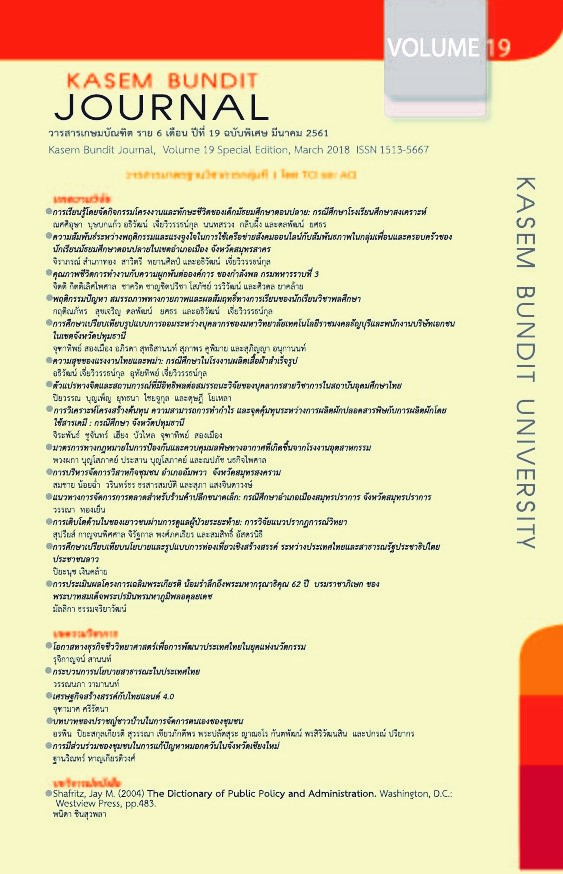โอกาสทางธุรกิจชีววิทยาศาสตร์เพื่อการพัฒนาประเทศไทยในยุคแห่งนวัตกรรม
Keywords:
โอกาสทางธุรกิจ; ชีววิทยาศาสตร์; เทคโนโลยีชีวภาพ; ความเป็นผู้ประกอบการ; นวัตกรรมAbstract
ธุรกิจชีววิทยาศาสตร์เป็นธุรกิจที่ขับเคลื่อนด้วยนวัตกรรมผ่านการวิจัยและพัฒนาเพื่อตอบสนองความต้องการในการพัฒนาคุณภาพชีวิตของมนุษย์ ปัจจุบันมีความเป็นไปได้ในการดำเนินธุรกิจและสร้างมูลค่าให้กับความเป็นชีววิทยาศาสตร์ประยุกต์ให้สอดคล้องและตอบโจทย์แก้ปัญหาของโลก ชีววิทยาศาสตร์เป็นส่วนสำคัญของเศรษฐกิจชีวภาพของนโยบายประเทศไทย 4.0 ช่วยเพิ่มประสิทธิภาพและส่งเสริมขีดความสามารถของมนุษย์ ขีดความสามารถของผู้ประกอบการ และเพิ่มคุณภาพชีวิตของประชาชนคนไทยอย่างยั่งยืน
โอกาสทางธุรกิจชีววิทยาศาสตร์ในประเทศไทยนั้นมีความเกี่ยวข้องกับ นวัตกรรมด้านชีววิทยาศาสตร์ได้แก่ Biotech/pharmaceutical, Life sciences, Medical device/diagnostics, Biotech/agriculture และ Digital health IT เป็นต้น สำหรับโอกาสในการต่อยอดงานวิจัยสู่การดำเนินธุรกิจครบวงจร (B2B, B2C และ B2G) โอกาสในการต่อยอดงานวิจัยและการพัฒนาและการวิจัยร่วมทั้งในและต่างประเทศ โอกาสในพัฒนาเป็นประเทศส่งออก raw material แหล่งสำคัญของโลก และโอกาสเพิ่มมูลค่าสู่การขาย ต้องพิจารณาทั้ง Triple Bottom Line (TBL) และ Triple Top Line (TTL) ซึ่งต้องครอบคลุมประเด็นที่เกี่ยวข้องกับเศรษฐกิจ สิ่งแวดล้อมและสังคม รวมถึงกลยุทธ์ที่เน้นความเสมอภาคทางสังคม ตอบสนองอย่างรวดเร็วกับระบบนิเวศ และเสถียรภาพทางเศรษฐกิจ ซึ่งผู้ประกอบการธุรกิจชีววิทยาศาสตร์ต้องเตรียมความพร้อมของตนเองเพื่อให้เป็นที่ยอมรับและสนใจจากนักลงทุนทั้งในและต่างประเทศ
Life science is a business driven innovation through research and development to meet the needs of improving the quality of human life. Which is a business driven innovation through research and development to meet the needs of quality of life in this day. There are many possible ways to run a business and create value for the sake of bioscience in order to meet and solve the problems of the world which in the bioeconomy of Thailand 4.0 policy. Biotechnology can help to efficiency and enhance human capabilities, entrepreneur and improve the population in Thailand.
Life science business opportunity involve with the innovation such as Biotech/pharmaceutical, Life sciences, Medical device/diagnostics, Biotech/agriculture and Digital health IT. The opportunity to accelerate to the full scale business (B2B, B2C and B2G), co-research around the world, raw material country and make value added to spin-off. Entrepreneur should consider Triple Bottom Line (TBL) and Triple Top Line (TTL) which involve economic, environment and social responsibility. And also concern about social equity, ecological sensitivity and economics soundness. Finally, entrepreneur should prepare themselves to be accepted and interested by both domestic and foreign investors.
References
The Stock Exchange of Thailand. (2560). Spin-off for listed company, Retrieved 26 November, 2017 from https://www.set.or.th/th/products/listing/files/Brochure_Spin_Off_B.pdf
ศูนย์ธุรกิจสัมพันธ์ กรมเศรษฐกิจระหว่างประเทศ. (2560). โอกาสในด้านวิทยาศาสตร์การแพทย์และชีววิทยาศาสตร์ของไทย โดย ศูนย์ธุรกิจสัมพันธ์ กรมเศรษฐกิจระหว่างประเทศ กระทรวงการต่างประเทศ สืบค้นเมื่อ 26 พฤศจิกายน 2560 จาก https://globthailand.com/germany_0010/
Ministry of Foreign Affairs. (2560). The opportunity of medical and biotechnology in Thailand, Retrieved 26 November, 2017 from https://globthailand.com/germany_0010/
สำนักงานคณะกรรมการพัฒนาการเศรษฐกิจและสังคมแห่งชาติ. (2560). แผนพัฒนาเศรษฐกิจและสังคมแห่งชาติ ฉบับที่สิบสอง พ.ศ. 2560-2564, สำนักงานคณะกรรมการพัฒนาการเศรษฐกิจและสังคมแห่งชาติ สำนักนายกรัฐมนตรี สืบค้นเมื่อ 26 พฤศจิกายน 2560 จาก https://www.nesdb.go.th/ewt_dl_link.php?nid=6422
Office of The National Economic and Social Development Board. (2560). The National Economic and Social Development Plan 2560-2564, Retrieved 26 November, 2017 from https://www.nesdb.go.th/ewt_dl_link.php?nid=6422
สาลินีย์ ทิมพิลา. (2560). ชีววิทยาศาสตร์: ธุรกิจแห่งอนาคต. สืบค้นเมื่อ 26 พฤศจิกายน 2560 จาก https://www.bangkokbiznews.com/news/detail/519504
Timpila, S. (2560). Biology Science: Businessuture for the future, Retrieved 26 November, 2017 from https://www.bangkokbiznews.com/news/detail/519504
Bialek-Jaworska, A., Bialek-Jaworska, A., Gabryelczyk, R., & Gabryelczyk, R. (2016). Biotech spin-off business models for the internationalization strategy. Baltic Journal of Management, 11(4), 380-404.
Chesbrough, H. (2003). Open innovation, the new imperative for creating and profiting from technology, Harvard Business School Press, Boston, MA.
Chesbrough, H. (2010). Business model innovation: opportunities and barriers. Long range planning, 43(2), 354-363.
Contractor, F. J., & Sagafi-Nejad, T. (1981). International technology transfer: Major issues and policy responses. Journal of International Business Studies, 12(2), 113-135.
Gambardella, A., & McGahan, A. M. (2010). Business-model innovation: General purpose technologies and their implications for industry structure. Long range planning, 43(2), 262-271.
Jeurissen, R. (2000). John Elkington, Cannibals with forks: The triple bottom line of 21st century business. Journal of Business Ethics, 23(2), 229-231.
Kunz, R., & Lloyd, B. (2017, June). Radical (Open) Innovation made in Germany: Biotech success stories. In ISPIM Innovation Symposium (p. 1). The International Society for Professional Innovation Management (ISPIM).
McDonough, W., & Braungart, M. (2002). Design for the triple top line: new tools for sustainable commerce. Corporate Environmental Strategy, 9(3), 251-258.
Osterwalder, A., & Pigneur, Y. (2010). Business model generation: a handbook for visionaries, game changers, and challengers. John Wiley & Sons.
Rialp, A., Rialp, J., & Knight, G. A. (2005). The phenomenon of early internationalizing firms: what do we know after a decade (1993–2003) of scientific inquiry?. International business review, 14(2), 147-166.
Savitz, Andrew. The triple bottom line: how today's best-run companies are achieving economic, social and environmental success-and how you can too. 2rd Edition, John Wiley & Sons, 2014.
Teece, D. J. (2010). Business models, business strategy and innovation. Long range planning, 43(2), 172-194.
Downloads
Published
How to Cite
Issue
Section
License
ทัศนคติ ความคิดเห็นใด ๆ ที่ปรากฏในวารสารเกษมบัณฑิตฉบับนี้เป็นของผู้เขียน โดยเฉพาะ มหาวิทยาลัยเกษมบัณฑิตและบรรณาธิการ ไม่จำเป็นต้องมีความเห็นพ้องด้วย







